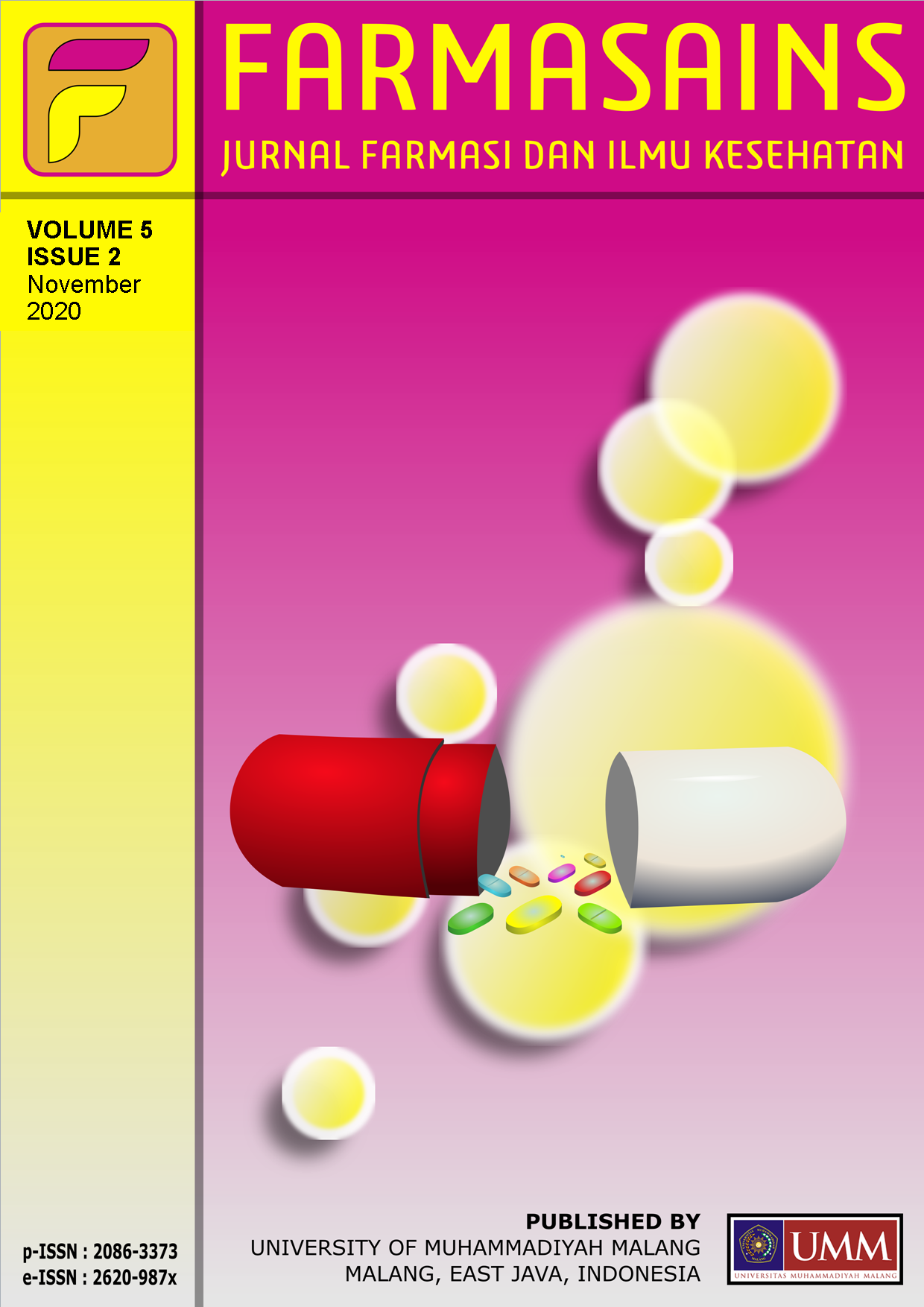Studies on antioxidant activity of red, white, and black pomegranate (Punica granatum L.) peel extract using DPPH radical scavenging method
DOI:
https://doi.org/10.22219/farmasains.v5i2.13472Keywords:
Antioxidant, Black pomegranate, Red pomegranate, White pomegranate, Peel extract, DPPHAbstract
Pomegranate (Punica granatum L.) has high antioxidant activity. In Indonesia, there are red pomegranate, white pomegranate, and black pomegranate. The purpose of this study was to determine the antioxidant activity of red pomegranate peel extract, white pomegranate peel extract, and black pomegranate peel extract. The extracts prepared by ultrasonic maceration in 96% ethanol, then evaporated until thick extract was obtained and its antioxidant activity was determined using the DPPH radical scavenging method. This study showed that all pomegranate peel extract varieties have potent antioxidant activity and the black pomegranate peel extract has the highest antioxidant power.
Downloads
References
Alam, M. N., Bristi, N. J., & Rafiquzzaman, M. (2013). Review on in vivo and in vitro methods evaluation of antioxidant activity. Saudi Pharmaceutical Journal, 21(2), 143-152. doi:10.1016/j.jsps.2012.05.002
Andriani, V. and Suharyanto. (2015). Karakterisasi Anatomi dan Aktivitas Antioksidan Delima (Punica granatum L.) (Master Thesis). Universitas Gajah Mada, Yogyakarta, Indonesia. Retrieved from http://etd.repository.ugm.ac.id/home/detail_pencarian/89446
Aslam, M. N., Lansky, E. P., & Varani, J. (2006). Pomegranate as a cosmeceutical source: Pomegranate fractions promote proliferation and procollagen synthesis and inhibit matrix metalloproteinase-1 production in human skin cells. Journal of Ethnopharmacology, 103(3), 311–318. doi:10.1016/j.jep.2005.07.027
Baihaqi, Budiastra, I. W., & Darmawati, E. (2018). Peningkatan Efektivitas Ekstraksi Oleoresin Pala Menggunakan Metode Ultrasonik. Jurnal Keteknikan Pertanian, 6(3), 249-254. doi:10.1017/CBO9781107415324.004
Bhandary, S., Kumari, S., Bhat, V., Sharmila, K., & Beka, M. (2012). Preliminary phytochemical screening of various extracts of Punica granatum peel, whole fruit and seeds. Nitte University Journal of Health Science, 2(4), 35–38. doi:10.1055/s-0040-1703609
Derakhshan, Z., Ferrante, M., Tadi, M., Ansari, F., Heydari, A., Hosseini, M. S., … Sadrabad, E. K. (2018). Antioxidant activity and total phenolic content of ethanolic extract of pomegranate peels, juice and seeds. Food and Chemical Toxicology, 114, 108-111. doi:10.1016/j.fct.2018.02.023
Jurenka, J. (2008). Therapeutic applications of pomegranate (Punica granatum L.): A review. Alternative Medicine Review, 13(2), 128–144.
Mackler, A. M., Heber, D., & Cooper, E. L. (2013). Pomegranate : Its Health and Biomedical Potential. Evidance-Based Complementary and Alternative Medicine, 2013, 903457. doi:10.1155/2013/903457
Middha, S. K., Usha, T., & Pande, V. (2013). A Review on antihyperglycemic and antihepatoprotective activity of eco-friendly punica granatum peel waste. Evidence-Based Complementary and Alternative Medicine, 2013, 656172. doi:10.1155/2013/656172
Molyneux P. (2004). The use of the stable free radical diphenylpicryl-hydrazyl (DPPH) for estimating anti-oxidant activity. Songklanakarin Journal of Science and Technology, 26(2), 211-219.
Rana, T., Narzary, D., & Ranade, S. A. (2010). Systematics and taxonomic disposition of the genus Punica L. Pomegranate. Fruit, Vegetable and Cereal Science and Biotechnology, 4(2), 19-25.
Downloads
Published
How to Cite
Issue
Section
License
Copyright (c) 2021 Uswatun Chasanah

This work is licensed under a Creative Commons Attribution 4.0 International License.
Authors who publish with this journal agree to the following terms:
a. Authors retain copyright and grant the journal right of first publication with the work simultaneously licensed under a Creative Commons Attribution License that allows others to share the work with an acknowledgement of the work's authorship and initial publication in this journal.
b. Authors are able to enter into separate, additional contractual arrangements for the non-exclusive distribution of the journal's published version of the work (e.g., post it to an institutional repository or publish it in a book), with an acknowledgement of its initial publication in this journal.
c. Authors are permitted and encouraged to post their work online (e.g., in institutional repositories or on their website) prior to and during the submission process, as it can lead to productive exchanges, as well as earlier and greater citation of published work (See The Effect of Open Access).













